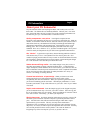
SV Subwoofers
Page 8
Phase. Think of bass waves as conflicting or enhancing each other, depending on
the timing of their arrival at your listening location (either together, or not). Since
some of your room’s bass might come from main, center and/or surround speakers,
as well as your sub, getting these bass wave forms to arrive in a complementary,
enhancing fashion is the difficult job of the phase knob. Essentially, this control
varies the timing of the bass waves coming from the sub. The effect of bass cancella-
tion will vary by volume and frequency in your room, and no one setting is likely to
ever be “perfect”. One simple technique to optimize phase is to find a nice “bassy”
loop (such as the menu of “Godzilla”) and measure the loop’s bass response at vari-
ous bass SPL peaks. As the loop runs, vary the phase knob. Where you see the most
response on a given bass passage is the phase setting providing the least bass cancel-
lation in your room (for the frequencies of the demo loop you chose). Adjusting
phase is mostly a concern in dual sub configurations or systems with “Large” mains.
Line In/Out. Use one of the sub’s “Line In” jacks to connect the subwoofer to the
output jack of your receiver/processor. Feeding just one input is enough. If you are
using a conventional amp and/or a stereo setup you can use the “Line Out” jacks to
send sound (filtered of bass information) back to your system amp. A simple RCA to
RCA cable is all you need.
Auto On. Your PC-Plus allows itself to be in an “auto on” mode… or on all the
time. With the former setting (the switch in the “Auto” position) your subwoofer
will “sense” that a DVD or CD etc. has begun and switch on immediately (the hard
power switch mentioned below must be on naturally). A few minutes after a movie,
the Auto On light will turn to Red, switching the sub back off. When running (and
sensing a signal) the Auto On LED will be green. Sometimes, with very low listening
levels, your subwoofer might not get enough of a bass signal from your surround
sound processor to “trip” the Auto-On circuit. Should you ever find this to be the
case you should leave this switch to “On” or raise the level of your receiver’s sub-
woofer output (recalibrate your sub!).
Crossover Enable Switch. If you allow your DD/DTS surround-sound receiver
or processor to manage bass frequencies (recommended), this switch should be set to
“Disabled”. This disables the “Crossover Frequency” knob and allows your sub to
reproduce just what it’s fed from the receiver. If you are using the sub in a two chan-
nel (stereo only) configuration then “Enable” the crossover and adjust the associated
knob to best blend the sub into the low frequency output of your speakers.
Subsonic (SS) Filter Switch. Your PC-Plus is “tuned” to work best above cer-
tain stock frequencies (the 25-31PC-Plus is 25Hz, the 20-39PC-Plus 20Hz etc.). But
the PC-Plus tri-port system allows you to use the included “port blocker” to tune
your sub significantly lower in just seconds (see the separate tuning sheet for more
on this). If you are running all three ports open on your 25-31PC-Plus then set the
SS switch to 25Hz. But if you are using the port plug, set the SS switch to 20Hz. A
20-39PC-Plus would use 20Hz or 15Hz settings (without and with the plug respec-
tively), the 16-46PC-Plus either 16Hz or 12Hz.
High level inputs/outputs. Not commonly used today, but binding posts are
there in case you don’t have low-level inputs/outputs on your receiver/processor.














